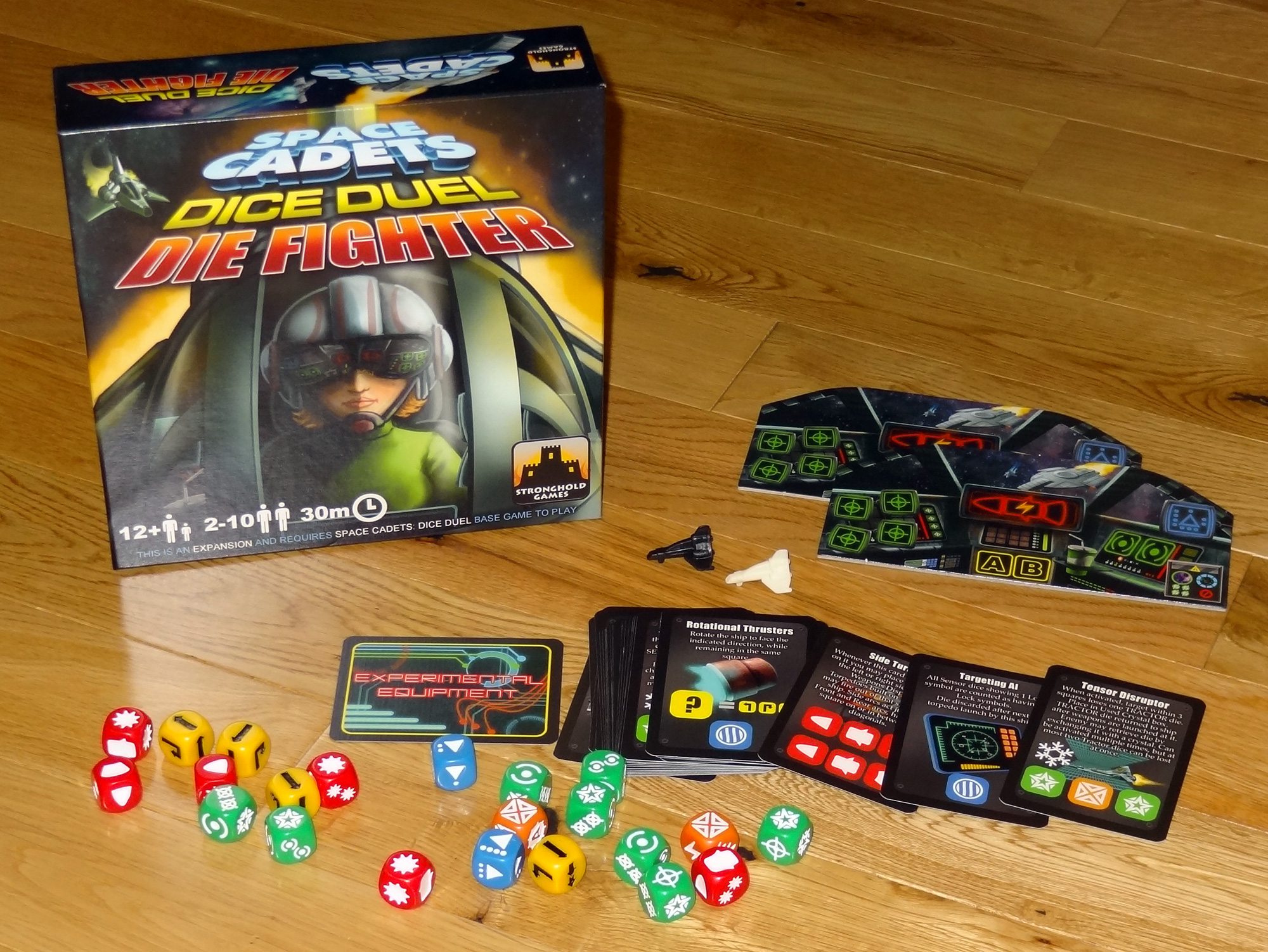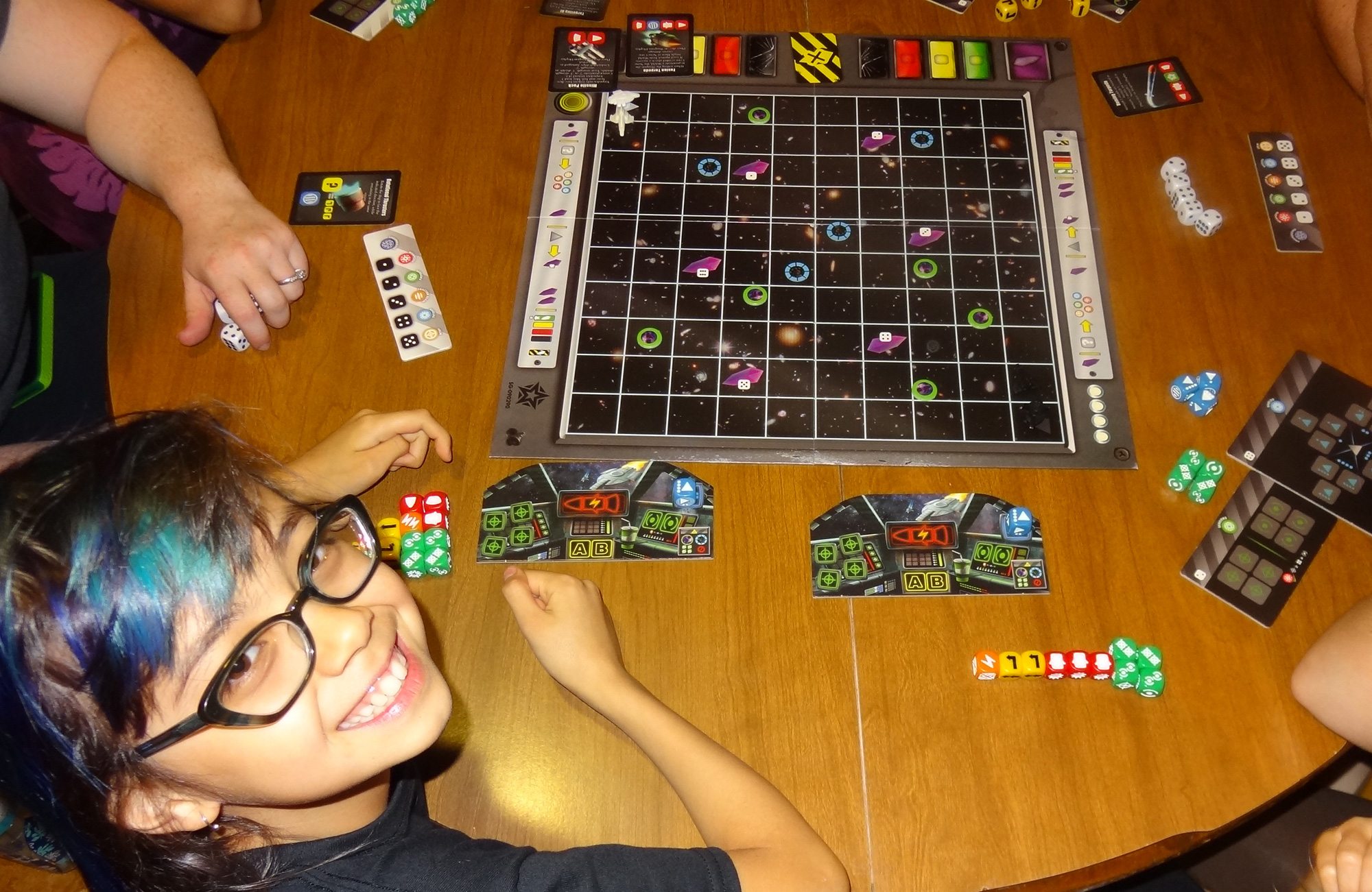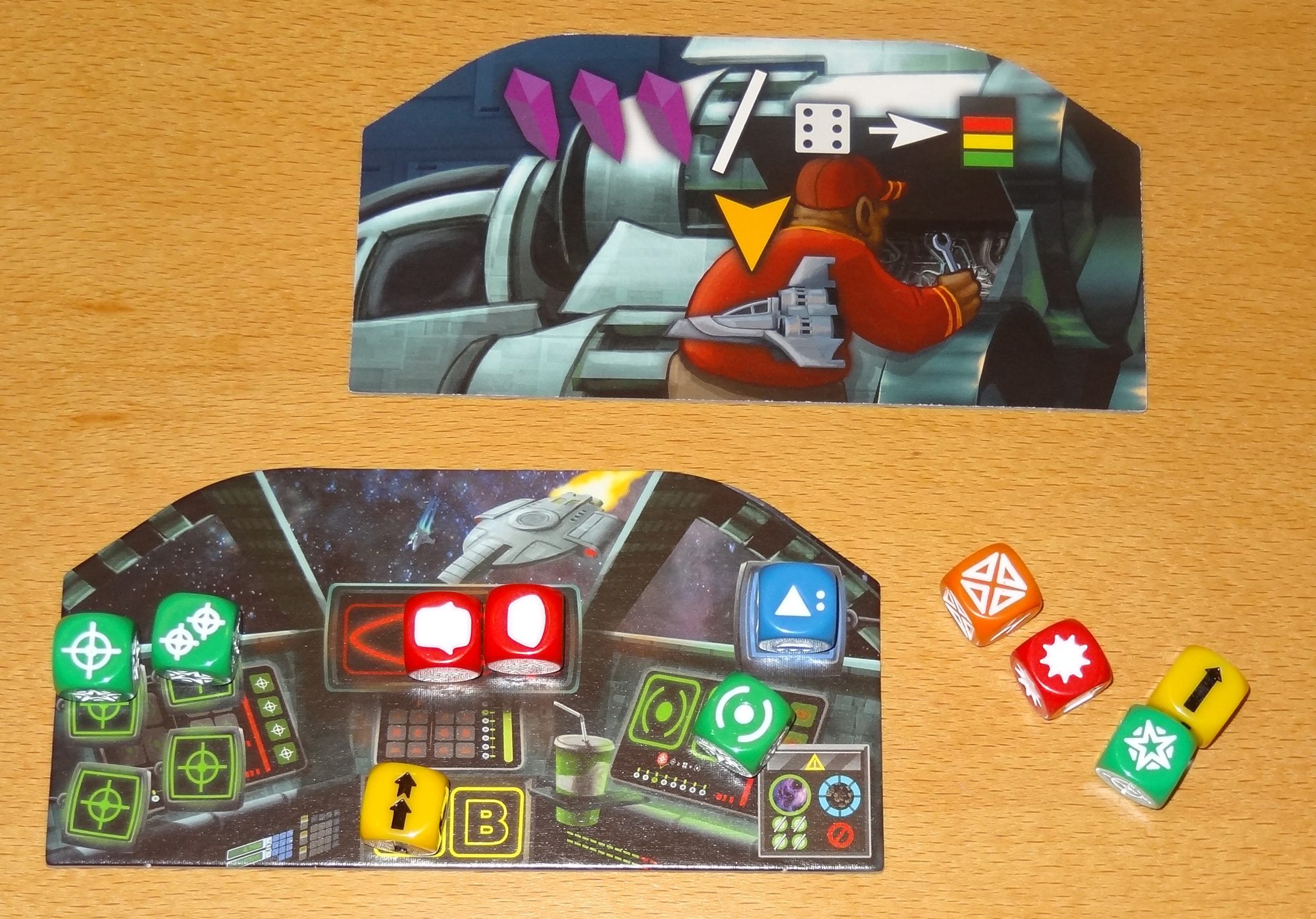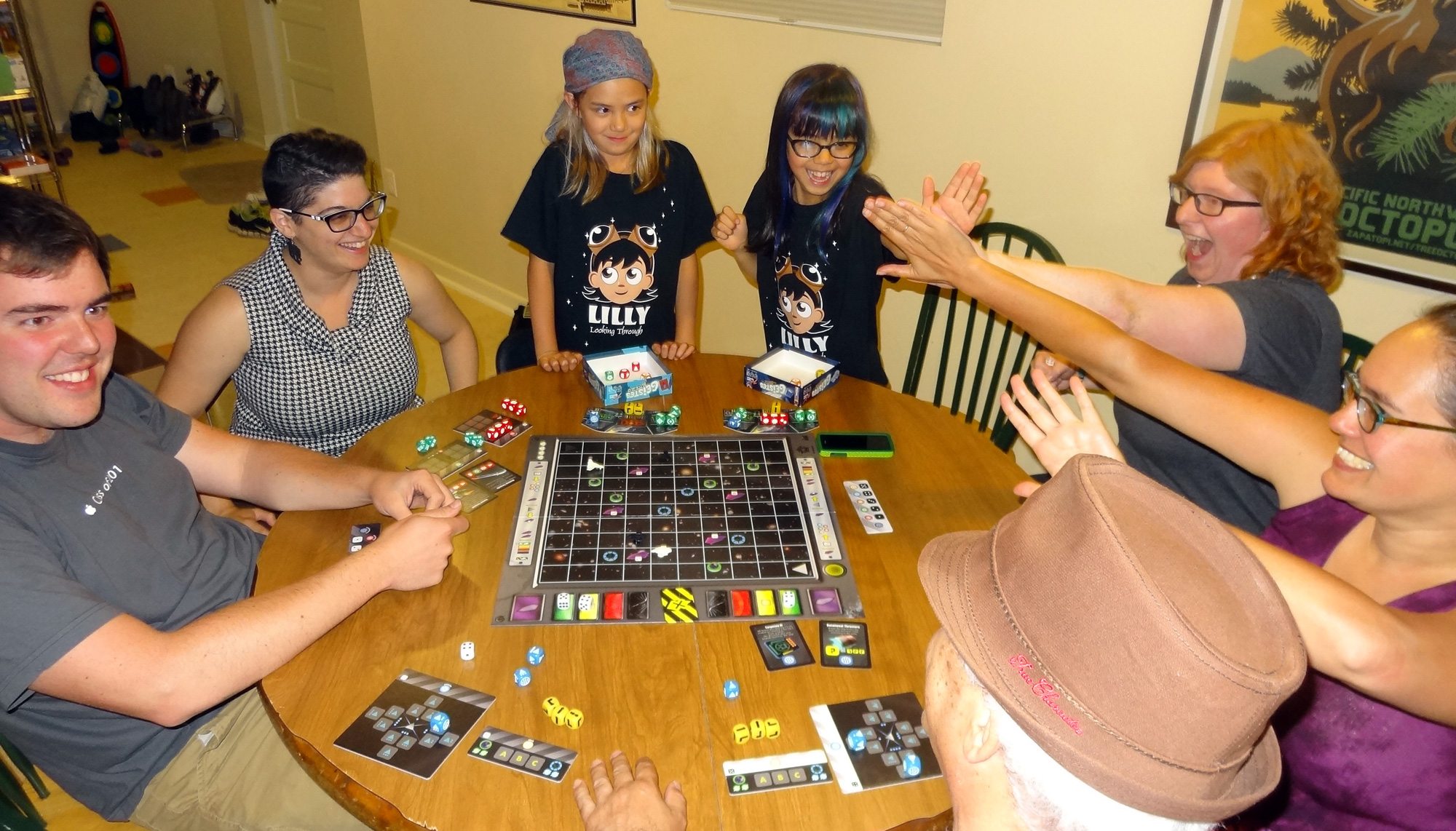
One of my favorite games from last year’s Gen Con was Space Cadets: Dice Duel, a real-time team-vs.-team shootout between two spaceships. You’re moving your ship around the board, loading torpedoes, energizing shields, setting target locks and jamming your opponent’s locks… all while rolling dice frantically. It’s a bit like playing Spaceteam—but with dice (and an opponent). I did an interview last year with the father-daughter team who designed the game, Geoff and Sydney Engelstein.
This year at Gen Con, Stronghold Games released an expansion: Die Fighter. It makes the game playable with only 2 players, and also extends it up to 10 players. And it’s a whole lot of fun.
In case you haven’t played the original Dice Duel yet, here’s a quick overview, and then I’ll get to the new stuff below. It’s for 4 to 8 players, ages 12 and up, and takes about 30 minutes (though the first time you’ll need to spend a while explaining the rules). I’ve played with younger kids, but the real-time die-rolling may be a bit stressful for some.
Each team gets five energy dice—the Engineer may roll these repeatedly, and then give them to various other stations if they’re the right numbers. When you get energy dice, then that lets you roll that many of your specialized dice, whether that’s to load torpedoes, program the ship’s movement, and so on. When you’ve picked a die and locked it onto your board, you return the energy dice to Engineering so they can be distributed to somebody else.
The real excitement comes when somebody shouts “Fire!” Then the game freezes, and you see if the torpedo hit. There are all sorts of things that can go wrong: you could be facing the wrong way (or not even anywhere close to the other ship); maybe you don’t even have torpedoes fully loaded; you might not have enough targeting locks to overcome the opponent’s jammers; or your torpedo might be stopped by shields. If you do manage to get through all of those barriers to success, then you do damage and the opposing team loses an energy die. The goal, of course, is to inflict four damage on your opponents, destroying their ship.
Here’s a very brief clip of the game in action. (Brief because I had to be ready to roll some helm dice if they came to me!)
So, on to the Die Fighter expansion!
At a glance: Die Fighter is for 2 to 10 players (but you need the Dice Duel base game), ages 12 and up, and takes about 30 minutes to play. It retails for $34.95, and will be available next week. Note: I played with my 7-year-old and 10-year-old and they did fine, though we did put them on separate teams to balance it out with the adults. I’d say if you wanted to play just the two-player version, you could get just the Die Fighter expansion and use a chessboard, but it’s really worth getting the full game for everything else.
Components:
Die Fighter comes with:
- 2 Fighter Cockpit boards
- 27 Experimental Equipment cards
- 2 plastic Fighter miniatures
- 22 custom dice (which actually match the original Dice Duel dice)
The dice are quite nice—custom six-sided dice in different colors to match the various stations, with the icons etched in and not just painted. I did, however, notice that a few dice here and there have smudged paint, but it didn’t affect gameplay.
The cards are decent quality—you won’t really need to shuffle these much and they’ll just be placed on the table for the entire game.
How to play
You can introduce the experimental equipment cards, the Fighters, or both.
First, the experimental equipment: You deal out five cards on the table. First team picks one, second team picks two, and then first team picks one more. The last card is discarded.

The two cards you picked are now permanent upgrades to your capital ship (the main ship). Some equipment gives you additional types of torpedoes, some give you different ways to maneuver your ship, some help you ignore obstacles on the board. Most of the equipment requires dice to activate them, so you’ll have to choose wisely—using the Fusion Torpedo means you have a better chance of blasting through somebody’s shields, but it also means you have fewer shields to protect yourself. (I learned this from experience: this cost my team the game.)
Next up: the Fighters.

The Fighters are small ships that can be launched from the capital ships. They fly independently and can help attack the enemy capital ship or get into dogfights with each other.
Each Fighter gets its own player board and a pile of dice: 4 Sensors, 3 Weapons, 2 Helms, 1 Tractor, and 1 Shield. The Shield die is only used as a health die—it’s placed on the board with 4 pips showing, and each time it takes a hit, it loses a point of health. No more health, and the Fighter blows up.
The pilot of the Fighter gets to roll all of their remaining dice, placing them onto the board as desired. They’re more nimble, flying after just two Helm dice are placed, but they only have a forward torpedo tube that holds one torpedo, and they have fewer jammer slots. They do get to ignore asteroids on the board, but passing through a nebula wipes out all four Sensor dice.
As usual, if a Fighter yells “Fire!” then the game freezes to figure out what the Fighter shot at and whether it does damage. The Fighter also has an additional weapon option: loading a Tractor die with a lightning bolt showing instead of the center torpedo segment makes it a Pulse Bomb. A Pulse Bomb may only be used against the capital ship—you have to get into the same space as the capital ship and then shout “Bomb.” It lets you roll two weapon dice (the nose and tail that were loaded), and blast symbols there can ignore shields and jammers on the capital ship. It’s a nice way to sneak in and do some damage, but it can also be dangerous getting so close to the capital ship.

There are three ways to use the Fighters: Carrier Strike, Fighter Assault, and Fighter Duel.
Carrier Strike just adds the Fighters to Dice Duel: each team gets a Fighter, and you can assign one player to be the pilot while the others divvy up the remaining stations. If a Fighter gets shot down, it can be relaunched for the cost of one energy die or three crystals. (Launching pauses the game while station duties are reassigned, and a different player can be the pilot each time.)
Fighter Assault is an asymmetric game: one team gets the capital ship (and up to 4 players), while the other team consists of two Fighters. The goal is to eliminate the enemy—and the Fighters cannot be relaunched if destroyed.
Finally, Fighter Duel is a dogfight for two players. Use only the two Fighters and no capital ships, and try to shoot the other player down.

The Verdict
I’ll start with this: Dice Duel is a brilliant game, and Die Fighter is a perfect expansion for it.
First, I love that I can now play with even more players (though that hasn’t often been the issue), and especially that I can play with only two players. In fact, my daughters have been playing some dogfights against each other. That’s not something I’ve been able to do with the original game.
Second, the experimental equipment is a lot of fun—it makes the teams slightly asymmetric, giving you different strengths and weaknesses, rather than the pure mirror match of the original. I love the fact that you have to choose between using your dice for their original purposes and powering up your equipment with them. And since there are 27 cards but you only use four per game, there’s a lot of replayability and variety there.
Third, the dice: the dice are the same as in the original game. There are special symbols on some of the dice that weren’t used in the base game, and I love the fact that they planned ahead. It’s a nice touch, being able to reuse these. Sure, it saves them money by not having to create new molds, but it also means they’re all familiar components.
Finally, the Fighter. It’s a different feel, being able to control movement, weapons, and sensors all by yourself, with no need to wait for energy dice. It makes Fighters much more nimble, because you aren’t dependent on another station before you can take actions. However, it also means that you’re rolling up to ten dice at once, which can be overwhelming. My kids both really wanted to try piloting the Fighters, and they did fairly well—most of the time they just flew around shooting at each other, but there was one Pulse Bomb attempt (which failed). It’s interesting to have this almost independent game going on while the rest of the players are playing Dice Duel. In a game like this, more chaos = more fun.
If you’re a fan of Dice Duel already, you’ll definitely want to pick up Die Fighter when it hits stores next week. If you haven’t played the original, I highly recommend it—or you could try my suggestion of playing just Die Fighter on a chessboard (which is smaller than the actual board) to get a feel for the game, but you won’t have access to the experimental equipment, and you’d need to look up rules for using the target locks and jammers from the original game. Plus, once you play Die Fighter I’m pretty sure you’ll want the full game anyway.
I will note that there are some people who would not enjoy Dice Duel: boring people. No, just kidding. Not everyone likes real-time games, because they’re quite stressful. You actually look forward to somebody shouting “Fire!” because then at least you can take a break and recover, even if you’re the one getting shot at. It’s also not great if you can’t roll dice quickly, hear what people are shouting, and see across the table to figure out where the ships are and whether your opponent has shields and jammers—so it may be difficult for anyone who is visually impaired, hard of hearing, or has trouble with dexterity.
Otherwise, Dice Duel is a fantastic blend of strategy game and party game, and Die Fighter lets you invite even more people to the party. You can place an order with Stronghold Games directly, order from Amazon, or watch for it at your local game store soon.
Disclosure: Stronghold Games provided a review copy of Die Fighter.





Thank you for the review! I’ve been looking for a “jet fighter” themed game that reminds me of the Ace Combat series. This game seems like it has many of the mechanisms I’m looking for; customization of weapons, more that 2-players, lighter rules. I’ll have to check this out!
It was quite fun. Glad I got to be part of the experience! I’ll be putting Dice Duel and Die Fighter on my wish list for sure!
It was great having you guys over, too! And I think the new expansion is perfect for your two-player reviews.
We had a blast playing this with all of you! Terrific game and well-thought-out expansion!